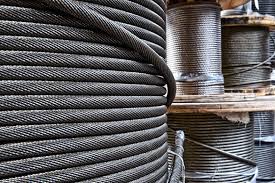Steel wire ropes are critical components used across a variety of industries for applications that require strength, flexibility, and durability. From the construction of skyscrapers to the operation of cranes and lifts, steel wire ropes are an essential part of the infrastructure that drives global economies. The global steel wire rope market size attained a value of USD 9038 million in 2023. The market is projected to further grow at a CAGR of 3.4% between 2024 and 2032 to reach a value of USD 10991 million by 2032. This growth is largely driven by the increasing demand from key end-use industries, including construction, mining, oil and gas, marine, and aerospace, all of which rely on high-performance steel wire ropes for safety, efficiency, and reliability.
In this blog post, we will explore the steel wire rope market’s current landscape, its various segments, regional dynamics, and the factors that are shaping its future growth from 2024 to 2032.
Market Overview
The steel wire rope market is experiencing steady growth due to the robust demand from several high-growth industries. These industries require steel wire ropes for a variety of applications, including lifting, hoisting, tensioning, and supporting structures. The growth of the construction sector, particularly in emerging markets, is one of the key drivers of market expansion. Additionally, as industries continue to push for higher productivity and efficiency, the need for durable and high-performance steel wire ropes becomes increasingly important.
In 2023, the global steel wire rope market was valued at USD 9038 million, with growth driven by advancements in material science, manufacturing techniques, and the demand for more robust and corrosion-resistant ropes. The market is forecasted to grow at a CAGR of 3.4%, reaching an estimated value of USD 10991 million by 2032.
Segmentation Analysis
By Type of Lay
Regular Lay
Regular lay ropes are the most commonly used configuration for steel wire ropes. They are made by twisting the wires in the same direction, making them highly flexible and durable. Regular lay ropes are typically used in applications where high strength and flexibility are required, such as lifting and hoisting. This type of lay offers the advantage of uniform wear and is widely used in industries like construction, offshore drilling, and mining. As industries continue to expand, the demand for regular lay ropes is expected to maintain steady growth.
Lang Lay
Lang lay steel wire ropes feature wires that are laid in a parallel direction, making them more resistant to abrasion compared to regular lay ropes. Lang lay ropes are typically used in applications where the rope is subjected to high tension and bending, such as in the marine and oil & gas sectors. These ropes are well-suited for heavy-duty lifting and are often used in critical infrastructure projects.
Alternate Lay
Alternate lay ropes combine the strengths of regular and Lang lay ropes by alternating the direction of the wire lay. This design increases the rope’s resistance to wear and enhances its load-bearing capacity, making it suitable for dynamic applications, including cranes, elevators, and suspension bridges. Alternate lay ropes are increasingly being used in sectors where high-strength and flexibility are paramount.
By Strand Pattern
Single Layer
Single-layer steel wire ropes consist of a single set of wires, typically used in less demanding applications where flexibility and strength are key requirements. They are often used in lower-load applications such as cable cars, smaller cranes, and general-purpose lifting operations.
Filler Wire
Filler wire ropes include a filler wire inserted between the main wires, improving the rope’s overall flexibility and reducing wear. This type of rope is commonly used in applications where smooth operation and minimal friction are required, such as in conveyors and mechanical systems.
Seals
Seals are a type of rope designed with additional seals placed between the strands to improve the rope’s durability and performance. These ropes are particularly useful in highly demanding environments, such as in offshore drilling, where they are exposed to harsh weather conditions and need enhanced protection from corrosion and fatigue.
Warrington
Warrington ropes are designed with a mix of thick and thin wires, providing a combination of strength and flexibility. This makes them suitable for heavy-duty lifting and applications that require a balance between load-bearing capacity and ease of handling. Warrington ropes are commonly used in the construction and mining sectors.
Combination
Combination ropes mix various strand patterns, such as combining Warrington and filler wire patterns, to offer a balance of strength, flexibility, and wear resistance. These ropes are particularly useful in complex machinery or high-stress environments where multiple performance attributes are required.
By Steel Type
Stainless Steel
Stainless steel wire ropes are highly resistant to corrosion, making them ideal for use in harsh environments such as offshore oil rigs, marine applications, and chemical industries. Their durability and resistance to environmental factors like moisture and saltwater make them a preferred choice for industries that require long-lasting and low-maintenance solutions.
Galvanized Steel
Galvanized steel ropes are coated with zinc to provide corrosion resistance at a lower cost compared to stainless steel ropes. These ropes are widely used in applications such as construction, cranes, and transportation, where moderate exposure to environmental elements is expected. Galvanized ropes offer a good balance of cost-effectiveness and durability.
By Coating Type
Vinyl Coating
Vinyl-coated steel wire ropes offer enhanced protection against wear and corrosion. The coating provides a smooth, protective layer that helps to reduce friction and wear, extending the rope’s lifespan. Vinyl-coated ropes are commonly used in applications where aesthetics and safety are important, such as in architectural designs, cable railings, and gym equipment.
Zinc Coating
Zinc-coated steel wire ropes (galvanized ropes) are coated with zinc to prevent corrosion, particularly in outdoor and marine applications. The zinc coating helps to protect the rope from the damaging effects of moisture and environmental pollutants, making it suitable for a wide range of industries, including shipping, oil & gas, and construction.
Others
Other coating options, such as polyurethane and epoxy coatings, are gaining popularity in specialized applications where higher durability, chemical resistance, and environmental protection are required. These coatings are often used in heavy-duty industries such as mining, construction, and offshore drilling.
By Application
Construction and Infrastructure
Steel wire ropes are extensively used in the construction industry for lifting heavy materials, suspending structures, and providing tension support for bridges and buildings. The continuous growth of the global construction sector, driven by urbanization and infrastructure projects, is a significant factor supporting the demand for steel wire ropes in this sector.
Mining and Excavation
The mining industry relies heavily on steel wire ropes for lifting, hoisting, and transporting materials. With the continued demand for mineral resources, particularly in developing countries, the mining sector is expected to remain one of the largest consumers of steel wire ropes, especially for high-strength and durable ropes that can withstand the harsh conditions of underground mining.
Marine and Offshore
In the marine industry, steel wire ropes are used for a variety of applications, including mooring, lifting, and securing cargo. Offshore oil rigs and vessels also require highly durable and corrosion-resistant ropes to withstand the harsh marine environment. As the global energy demand continues to rise, the marine and offshore sectors will remain key drivers of market growth.
Oil & Gas
Steel wire ropes are crucial for oil and gas exploration and extraction activities, especially in offshore drilling and subsea operations. These ropes are used in drilling rigs, cranes, and lifting systems, and their demand is expected to grow as energy companies continue to invest in exploration activities worldwide.
Aerospace
In the aerospace industry, steel wire ropes are used for various applications, including aircraft control systems, landing gear mechanisms, and suspension cables. The growing demand for commercial and military aircraft globally is expected to increase the need for high-performance steel wire ropes in this sector.
Regional Analysis
North America
North America is a significant market for steel wire ropes, driven by demand in the oil and gas, mining, and aerospace industries. The region’s strong infrastructure and construction sectors, combined with increasing investments in renewable energy projects, are also contributing to market growth.
Europe
Europe’s steel wire rope market is supported by a mature industrial base and stringent regulations that demand high-quality, durable materials. Key industries driving growth include marine, aerospace, and construction. The push for sustainability is also influencing the demand for environmentally friendly coating options.
Asia-Pacific
The Asia-Pacific region is expected to experience the highest growth in the steel wire rope market, fueled by rapid industrialization, urbanization, and the increasing demand for infrastructure development. Countries like China, India, and Japan are significant consumers of steel wire ropes in sectors such as construction, mining, and manufacturing.
Latin America and Middle East & Africa
The steel wire rope market in Latin America and the Middle East & Africa is driven by the growth in oil and gas, mining, and construction industries. Increasing investment in infrastructure projects and industrialization is expected to support market expansion in these regions.
Competitive Landscape
The global steel wire rope market is competitive, with several key players focusing on product innovation, regional expansion, and strategic partnerships. Leading companies in the market include WireCo WorldGroup, Usha Martin, and Bridon-Bekaert, which are continuously enhancing their product portfolios to meet the evolving demands of industries like mining, construction, and offshore drilling.
Market Forecast (2024-2032)
The global steel wire rope market is projected to grow at a CAGR of 3.4% between 2024 and 2032, reaching a value of USD 10991 million by 2032. This growth will be driven by the increasing demand for steel wire ropes in construction, mining, oil and gas, marine, and aerospace applications. Technological advancements, such as the development of high-strength, corrosion-resistant materials and coatings, will further support market growth.



